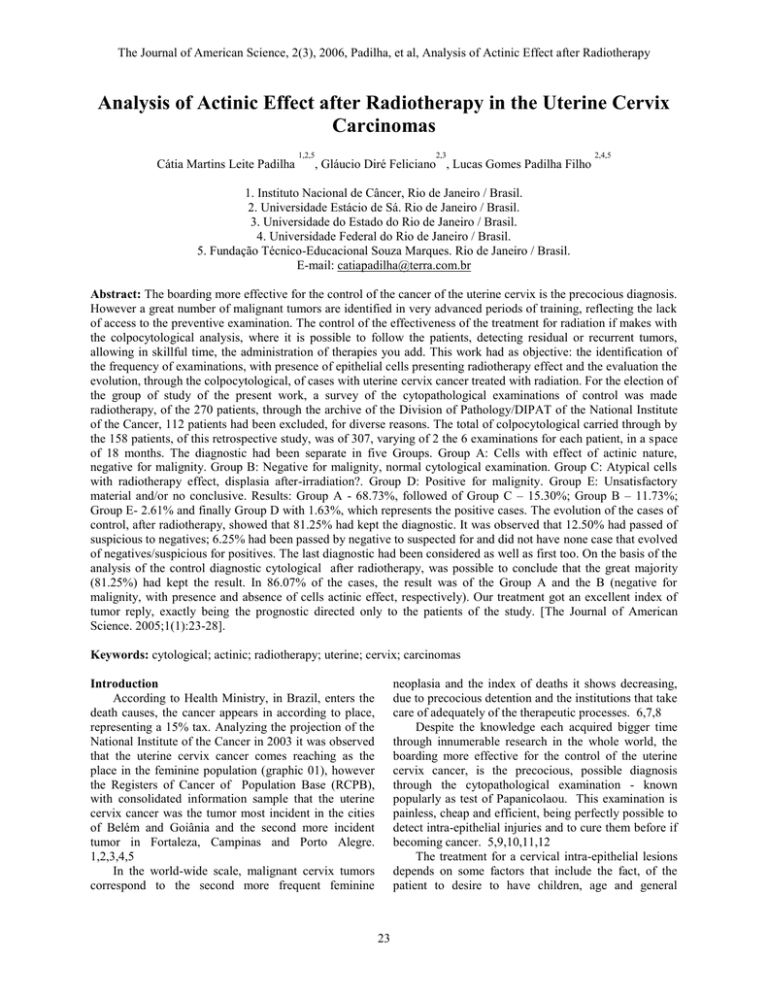Analysis of Actinic Effect after Radiotherapy in the Uterine Cervix Carcinomas
advertisement

The Journal of American Science, 2(3), 2006, Padilha, et al, Analysis of Actinic Effect after Radiotherapy Analysis of Actinic Effect after Radiotherapy in the Uterine Cervix Carcinomas 1,2,5 Cátia Martins Leite Padilha 2,3 2,4,5 , Gláucio Diré Feliciano , Lucas Gomes Padilha Filho 1. Instituto Nacional de Câncer, Rio de Janeiro / Brasil. 2. Universidade Estácio de Sá. Rio de Janeiro / Brasil. 3. Universidade do Estado do Rio de Janeiro / Brasil. 4. Universidade Federal do Rio de Janeiro / Brasil. 5. Fundação Técnico-Educacional Souza Marques. Rio de Janeiro / Brasil. E-mail: catiapadilha@terra.com.br Abstract: The boarding more effective for the control of the cancer of the uterine cervix is the precocious diagnosis. However a great number of malignant tumors are identified in very advanced periods of training, reflecting the lack of access to the preventive examination. The control of the effectiveness of the treatment for radiation if makes with the colpocytological analysis, where it is possible to follow the patients, detecting residual or recurrent tumors, allowing in skillful time, the administration of therapies you add. This work had as objective: the identification of the frequency of examinations, with presence of epithelial cells presenting radiotherapy effect and the evaluation the evolution, through the colpocytological, of cases with uterine cervix cancer treated with radiation. For the election of the group of study of the present work, a survey of the cytopathological examinations of control was made radiotherapy, of the 270 patients, through the archive of the Division of Pathology/DIPAT of the National Institute of the Cancer, 112 patients had been excluded, for diverse reasons. The total of colpocytological carried through by the 158 patients, of this retrospective study, was of 307, varying of 2 the 6 examinations for each patient, in a space of 18 months. The diagnostic had been separate in five Groups. Group A: Cells with effect of actinic nature, negative for malignity. Group B: Negative for malignity, normal cytological examination. Group C: Atypical cells with radiotherapy effect, displasia after-irradiation?. Group D: Positive for malignity. Group E: Unsatisfactory material and/or no conclusive. Results: Group A - 68.73%, followed of Group C – 15.30%; Group B – 11.73%; Group E- 2.61% and finally Group D with 1.63%, which represents the positive cases. The evolution of the cases of control, after radiotherapy, showed that 81.25% had kept the diagnostic. It was observed that 12.50% had passed of suspicious to negatives; 6.25% had been passed by negative to suspected for and did not have none case that evolved of negatives/suspicious for positives. The last diagnostic had been considered as well as first too. On the basis of the analysis of the control diagnostic cytological after radiotherapy, was possible to conclude that the great majority (81.25%) had kept the result. In 86.07% of the cases, the result was of the Group A and the B (negative for malignity, with presence and absence of cells actinic effect, respectively). Our treatment got an excellent index of tumor reply, exactly being the prognostic directed only to the patients of the study. [The Journal of American Science. 2005;1(1):23-28]. Keywords: cytological; actinic; radiotherapy; uterine; cervix; carcinomas neoplasia and the index of deaths it shows decreasing, due to precocious detention and the institutions that take care of adequately of the therapeutic processes. 6,7,8 Despite the knowledge each acquired bigger time through innumerable research in the whole world, the boarding more effective for the control of the uterine cervix cancer, is the precocious, possible diagnosis through the cytopathological examination - known popularly as test of Papanicolaou. This examination is painless, cheap and efficient, being perfectly possible to detect intra-epithelial injuries and to cure them before if becoming cancer. 5,9,10,11,12 The treatment for a cervical intra-epithelial lesions depends on some factors that include the fact, of the patient to desire to have children, age and general Introduction According to Health Ministry, in Brazil, enters the death causes, the cancer appears in according to place, representing a 15% tax. Analyzing the projection of the National Institute of the Cancer in 2003 it was observed that the uterine cervix cancer comes reaching as the place in the feminine population (graphic 01), however the Registers of Cancer of Population Base (RCPB), with consolidated information sample that the uterine cervix cancer was the tumor most incident in the cities of Belém and Goiânia and the second more incident tumor in Fortaleza, Campinas and Porto Alegre. 1,2,3,4,5 In the world-wide scale, malignant cervix tumors correspond to the second more frequent feminine 23 The Journal of American Science, 2(3), 2006, Padilha, et al, Analysis of Actinic Effect after Radiotherapy health. A patient with lesions of high degree (HSIL, High grade squamous intra epithelial lesion/ LSIL, low grade squamous intra epithelial lesion) can not need additional treatment, especially if the abnormal area completely was removed during the biopsy, but it must carry through a test of regularly carried through Papanicolaou and a pelvic examination. When the injury requires a treatment, the doctor will be able to use destructive therapies as the cryosurgery (freezing), cauterization (burning), or laser (surgery to destroy the abnormal area without damaging the fabric healthy adjacent). However, a great number of diagnosis is made when the tumors are in periods of training very advanced, reflecting the lack of access to the preventive examination, for difficulties in longdistance relation, ignorance or even though misinformation. The supervened average of the women diagnosed with uterine cervix tumors, classified as stadiums IIB (classification according to FIGO/Fédération Internationale de Gynécologie et d'Obstétrique) in ahead, for example, that they make the conventional treatment for pelvic radiotherapy, turns around 40%. The control of the effectiveness of the treatment for radiation if makes with the colpocytological analysis, where it is possible to follow the patients, detecting residual or recurrent tumors, allowing in skillful time, the administration of therapies you add. the 8,13,14,15,16 Even so cellular alterations provoked by the action of the ionizing radiation well are told in literature and are of great relevance, in some countries of the world, our Country still have great necessity of more studies. The cytological evaluation of the actinic effect, deserves great attention and training, for account This work had as objective: the identification of the frequency of examinations, with presence of epithelial cells presenting radiotherapy effects and the evaluation the evolution, through the colpocytology, of cases with uterine cervix cancer treated with radiation. of the importance in the therapeutic control of the patients after radiotherapy. 17,18,19,20,21,22,23 the basis of the rules of the FIG (Fédération Internationale de Gynécologie et d'Obstétrique) is demonstrated (picture 01). Election of the Patients For the election of the group of study of the present work, a survey of the cytopathological examinations of control was made after radiotherapy, of the 270 patients, through the archive of the Division of Pathology/DIPAT of the National Institute of the Cancer. Later, it had the analysis of handbooks of the cases that had colpocytology of control, for attainment of excellent data. By not possessing no cytological finding of control after radiotherapy 90 patients had been excluded, in the archives of INCA, 06 for not returning and 16 for arriving at the death. The total of colpocytology carried through for the 158 patients, of this retrospective study, was of 307, varying of 2 the 6 examinations for each patient, in a space of 18 months. The first colpocytology of control after radiotherapy, of each patient, after had an interval of 3 to 6 months the ending of the treatment. Considering that the frequency of examinations, carried through after radiotherapy, varied of patient the patient; the concrete analysis was made through the result of last examination of control, what it reflects the situation of the evolution of the patients until November of 2003. The diagnostic had been separate in five Groups. Group A: Cells with effect of actinic nature, absence of malignity. Group B: Negative for malignity, normal cytological examination. Group C: Atypical cells with radiotherapy effect, displasia afterirradiation? (suggestive of return). Group D: Positive for malignity. Group E: Unsatisfactory material and/or inconclusive. Results The ages of the patients had varied of 35 to 88 years, with average of 59.5 years. Related to the colpocytology examinations which has been carried through, were observed that more of the half of the diagnostic they were of the Group A - 68.73%, followed of Group C – 15.30%; Group B – 11.73%; Group E 2.61% and finally Group D with 1.63%, which represents the positive cases, as indicated in the Table 1. In the Table 2 is demonstrated the result of the last colpocytology examination of control after radiotherapy of each group. The evolution of the cases of control, after radiotherapy is represented in Table 3, where the percentage of each diagnosis is demonstrated, considering only first and the last diagnosis. Materials and Methods Characteristic of the Sample In July of 2003, through the folder of archive, in the Service of Gynecology of the Hospital of Oncology (HC II/INCA), the patients with scaly uterine cervix carcinoma had been catalogued, directed to the radiotherapy, in the period of January the July of 2000, representing a total of 270 patients. All the cases had cytological examination confirmed by the biopsy, before the treatment. In accordance with the registers, in the great majority of the directed patients, the tumors were local advanced; the clinical staging was carried through on 24 The Journal of American Science, 2(3), 2006, Padilha, et al, Analysis of Actinic Effect after Radiotherapy 12.00 6.00 5 Rates per 10 women 0.00 Figure 1. Rude taxes of mortality for 100,000 women for the tumor most frequent, Brazil, 1979-2000 and projection 2003. Source: Brazil, Health Ministry, National Institute of the Cancer. Estimate of the incidence and mortality by Cancer in Brazil. Square 1. Clinical staging, according to FIGO by each patient STAGES OF FIGO NUMBER OF CASES Stage I IA IA1 IA2 IB IB1 IB2 Stage II IIA IIB Stage III IIIA IIIB Stage IV IVA IVB --------19 --03 03 02 109 01 01 124 01 06 01 25 % OF THE CASES BY EACH CLINICAL STAGE --------7.04 --1.11 1.11 0.74 40.37 0.37 0,37 45.93 0.37 2.22 0.37 The Journal of American Science, 2(3), 2006, Padilha, et al, Analysis of Actinic Effect after Radiotherapy Table 1. Diagnostics of each group of the whole colpocytological exams realized after radiotherapy. Groups of the diagnostics Findings with each diagnostic Frequency of the cases (%) 211 68.73 Group A Group B 36 11.73 Group C 47 15.30 Group D 05 1.63 Group E 08 2.61 Table 2 has shown the results of the last colpocytological exam of control after radiotherapy of each group. Table 2. Diagnostics results of the last colpocytological exam of control after radiotherapy of each group. Groups of the diagnostics Findings with each diagnostic Frequency of the cases (%) 118 74.68 Group A Group B 16 11.39 Group C 18 10.13 Group D 03 1.90 Group E 03 1.90 The evolution of the cases of the control after radiotherapy is represented in the table 03 where is demonstrated the percentage of each group only considering the first and the last diagnostic. Table 3. Evolution of the cases of the control after radiotherapy. Evolution % of cases Keep the diagnostics 81.25 Suspects for negatives 12.50 Negatives for suspects 6.25 00 Negatives / suspects for positives 26 The Journal of American Science, 2(3), 2006, Padilha, et al, Analysis of Actinic Effect after Radiotherapy Discussion The radiated cells show some cytochemistry alterations that can be due to enzyme release for the cytoplasmic destruction of organelles. The increase of the RNA synthesis occurs to nucleolus followed for the reduction of the synthesis of the DNA. Small doses of radiation can intermittently intervene with the production of messenger RNA e, therefore, to diminish the protein synthesis. Great doses inhibit the DNA synthesis and can take the irreversible damages in the nuclear DNA. The mitotic activity can be suppressed temporarily. Chromosomal and genetic abnormalities can be observed and occasionally resulting in the loss of the ability of dividing while the nuclear and cytoplasmic metabolism continues. 20,24,25 According to Shuheko et al, the cytology showed to be good method of control of uterine cervix cancer treated by radiotherapy, therefore in accordance with its studies, had not had cases false-positives and nor false negatives. 21,22 The pursuing through the colpocytology is important, mainly in the two first immediate years to therapeutic, due to the fact that 50% of the recurrences are detected in the first year of pursuing as well as 85% with two years. In five years of pursuing, 95% of the returns will have been detected. Some groups of patients can after benefit with a systematic pursuing the treatment. 9,10,21,22 Campos has observed that the identification of malignant cells to the end of the treatment indicates that the tumor was not sterilized, while that its absence always does not mean activity lack, therefore can be had carried through a local sterilization of the tumor while persists in lymphatic or parametric ganglia. More than 80% of the patients were into menopause, however 60% of the smears were observed little more than were atrophics. 26 In accordance with some studies, the return occurs precociously during the pursuing and about 85% of these patient ones they go the death in two years. Our findings show that before the pursuing 06% of the patients had arrived at the death. 27,28,29,30 According to Teixeira et al, only 24% of the patients who had had complete reply to the radiotherapy had come back to have tumor activity, mainly in the two first years of pursuing, evidencing that the therapeutic reply it could be used as parameter for the prognostic definition in advanced cases. 16 presence and absence of cells c/actinic effect, respectively). The treatment got an excellent index of tumor reply, exactly being the prognostic directed only to the patients of the study. The analysis of the evolution, through the colpocytology disclosed a small index of cases with actinic effect (negative for malignity) that the return cases had evolved suspicious - displasia afterirradiation (6.25%), and accurately the double of this value (12.50%), they were suspected and they had become negative. The result of the last examination of control disclosed an increase in relation to the total of examinations of the diagnostic of the Group A (5.95%), and a discrete reduction in group B (0.34%), which are negative, the first ones, with effect, actinic and as without evident actinic effect. It was a reduction of 5.17% in the diagnostic number of the Group C. The group D has shown a discrete reduction-0,27% and the diagnostic of the group E has presented an increase of 0.71%. The accompaniment of the patients must be made through the colpocytology examination, approximately 6 weeks after the treatment for radiation, with semester harvests in the 3 first years and after that annual, in case that it does not have return suspicion, thus preventing, any possibility of unsatisfactory materials for the reading, beyond negative false results, since the cytological criteria, continue, for times, subjective. It is of great relevance that the study continues, using others diagnostic techniques, as immunohistochemistry and cytogenetic, in the search of new markers that could differentiate the recidivates injuries of the actinic effect. Therefore the morphologic aspects are only insufficient, in some cases, to affirm a positive or negative diagnosis, without the necessity of the evolutionary accompaniment of the alterations, through annual the semester colpocytology. This comparative study it would search the evaluation of the values predictive-positives and predictive-negative, being able to make possible the reduction of the cases false-positives and false-negative, therefore method in study is, for times, limited. Correspondence to: Cátia Martins Leite Padilha Instituto Nacional de Câncer, Rio de Janeiro / Brasil. E-mail: catiapadilha@terra.com.br Conclusion On the basis of the analysis of the control cytological-diagnostic after radiotherapy, was possible to conclude that the great majority (81.25%) had kept the result. In 86.07% of the cases, the result was of the Group A and the B (negative for malignity, with Lucas Gomes Padilha Filho Universidade Estácio de Sá. Rio de Janeiro / Brasil. 27 The Journal of American Science, 2(3), 2006, Padilha, et al, Analysis of Actinic Effect after Radiotherapy 19. LA VECCHIA, C., et al. Pap smears and the risk of cervical neoplasia: quantitative estimates from a case-control study. Lancet, v. 2, p. 779-782, 1984. 20. LUDGATE, S. M., et al. Synchrounus 5-fluorouracil, mitomycin C and radiation therapy in the tratament of locally advanced carcinoma of the cervix. Int J Radiat Oncol Biol Phys, v. 15, p. 893-899, 1988. 21. PERRZ, C. A.; KURMA, R. J.; STEHMAN, F. B.; THIGPEN, J. T. Uterine cervix. In: HOSKINS, W. J.; PEREZ, C. A.; YOUNG, R. C. (Eds). Principles and practice of gynecologic oncology. Philadelphia: JB Lippincott, 1992. p. 591-662. 22. VIÉGAS, Célia Maria Pais. Químio e radioterapia em carcinoma localmente avançado de colo do útero. 2002. Tese (Doutorado em Medicina)-Universidade Federal do Rio de Janeiro, Rio de Janeiro, 2002. 23. JACYNTHO, C.; ALMEIDA FILHO, G.; MALDONADO, P. HPV infecção genital feminina e masculina. Rio de Janeiro: Revinter, 1994. 24. JIMENEZ AYALA, Matias; NAGALES ORTIZ, Francisco. Citopatologia ginecológica. Tradução: Alfredo Moraes, Silva Filho. [Madri]: Ed. Artes Médicas, 1978. 25. MARCIAL, V.A.; MARCIAL, L. V. Radiation therapy of cervical cancer: new develops. Cancer, v. 71, p. 1438-1445, 1993. 26. McKEE, G. T. Citopatologia. São Paulo: Artes Médicas, São Paulo, 1997. 27. MONTENEGRO, M. R; FRANCO, M. Patologia processos gerais. 4. ed. Rio de Janeiro: Atheneu, 1999. 28. SCHIFF, M. H., et al. Epidemiologic evidence showing that human papillomavirus infection causes most cervical intraepithelial neolplasia. J Natl Cancer Inst, v. 85, p. 958-964, 1993. 29. SCHINEIDER, M. L.; SCHINEIDER, V. S. Atlas de diagnóstico diferencial em citologia ginecológica. Germany: Revinter, 1998. 30. SHUHEKO, Marina; LONGATTO FILHO, Adhemar; MAEDA, Marina Sakamoto; SHIH, Lai Wun Song; BORTOLAN, Jeni. Importância do “follow-up” de carcinomas do colo uterino irradiados: I. efeitos imediatos (até 12 meses). Acta Oncológica Brasileira, v. 9, p. 17-20, 1989. 31. SHUHEKO, Marina, LONGATTO FILHO, Adhemar; MAEDA, Marina Sakamoto; SHIH, Lai Wun Song; BORTOLAN, Jeni. Importância do “follow-up” de carcinomas do colo uterino irradiados: II. efeitos tardios (após 12 meses). Acta Oncológica Brasileira, v. 9, p. 45-50, 1989. 32. SILVA FILHO, A. M.; LONGATTO FILHO, Adhemar. Colo uterino vagina: processos inflamatórios, aspectos histológicos, citológicos e colposcópicos. Rio de Janeiro: Revinter, 2000. 33. TEIXEIRA, J. C.; MONTI, C. R., DECHAIN, S. F. M.; TEIXEIRA, L. C. Radiotherapy and prognostic factors evaluation in patients with squamous cell carcinoma of the uterine cérvix – stage IIIb. Acta Oncológica Online, [São Paulo], Hospital A. C. Camargo, v. 20, n. 1, jan./fev./mar. 2000 Disponível em: < http://www.hcanc.org.br/acta/2000/acta2k_3.html>. Acesso em: nov. 2003. 34. WACHTEL, E. The pronostic significance of the female genitale tract. Acta Cytol, v. 11, p. 35, 1967. REFERENCES 1. 2. 3. 4. 5. 6. 7. 8. 9. 10. 11. 12. 13. 14. 15. 16. 17. 18. AMERICAN College of Obstetricians and Gynecologists. Cervical cytology: evaluation and management of abnormalities. ACOG Techinical Bulletin. Washington: American College of Obstetricians and Gynecologists, 1984. BERRINO, F., et al. Efficacy of screenig in preveting invasive cervical cancer: caso-control study in Milan, Italy. IARC Sci Publ, v. 76, p. 111-123, 1986. BIBBO, M. Comprehensive citopathology. Philadelphia: W.B. Saunders Company, 1991. BRASIL. Ministério da Saúde. DATASUS. Sistema de informações sobre a mortalidade: 1999. Disponível em:<http://www.datasus.gov.br>. A cesso em: no. 2003. BRASIL. Ministério da Saúde. Instituto Nacional de Câncer. Disponível em: <http://www.inca.gov.br/estimativas/2003/index.asp?link=serieh istorica.asp.>. Acesso: jul. 2004. BRASIL. Ministério da Saúde. Instituto Nacional de Câncer. Controle do câncer: uma proposta de integração ensino serviço. 3. ed. 1999. BRASIL. Ministério da Saúde. Secretaria de Assistência a Saúde. Instituto Nacional de Câncer. Viva mulher: programa nacional de controle do câncer de colo de útero e mama. 2002. BRINTON, L. A., et al. Epidemiology of cervical cancer by cell type. Cancer Res, v. 47, p. 1706-1911, 1982. CAMPOS, J. R. C. Persistent tumor cells in the vaginal smears and prognosis of cancer of the radiated cervix. Acta Cytol, v. 14, p. 519, 1970. CASTRO, S. V. Anatomia Fundamental. 3. ed. São Paulo: Makron books. 1985 . DALALOYE, J. F., et al. Effect of total treatment time on eventfree survival in carcinoma of the cervix. Gynecol Oncol, v. 60, p. 42-48, 1996. DANGELO, J. G.; FATTINI, C. A. Anatomia humana básica. São Paulo: Ed. Atheneu, 1990. FERLAY, J.; BRAY, F.; PISANI, P.; PARKIN, D. M. Globocan 2000: cancer incidence, mortality and prevalence worldwide [computer program]. Verssion 1.0. Lyon: Iarcpress, 2001. Disponível em: <http://www.dep.iarc.fr/globocan/globocan.htm>. Acesso em: nov. 2003. GARDNER, E.; GRAY, D. J.; O’RAHILLY, R. Anatomia: estudo regional do corpo humano. 4. ed. Rio de Janeiro: Guanabara Koogan. 1985. GIMENO, M. H. Quimioterapia experimental II: estudo de los efectos citomorfológicos de la radiacion y de la quimioterapia antitumoral sobre tejidos neoplasicos. Rev. Esp. Oncologia, v. 27, p. 393-403, 1980. GOMPEL, C.; KOSS, L. G. Citologia ginecológica e suas bases anatomoclínicas. [s. l.]: Ed. Manole, 1997. GRIGSBY, P. W.; PEREZ, C. A. Radiotherapy alone for medically inoperable carcinoma of the cervix: stage IA and carcinoma in situ. Int J RadiatOncol Biol Phys, v. 21, p. 375378, 1991. HARIMA, Y.; SHIRAHAMA, S.; HARIMA, K.; AOKI, S.; OHNISHI, T.; TANAKA, T.. Genetic alterations on chomossome 17p associated with response to radiotherapy in bulky cervical cancer. British Journal of cancer, v. 81, n. 1, p. 108-113, 1999. 28


